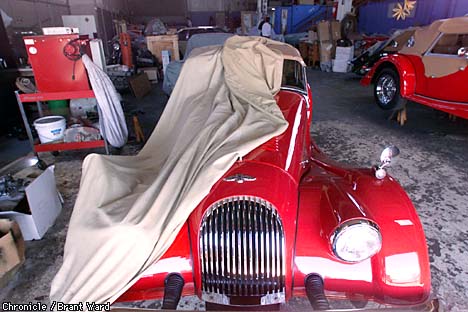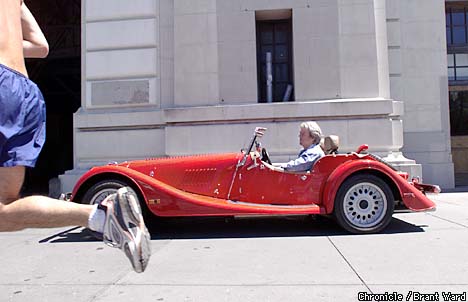 Setting
up shop at a scenic location, at the tip of Pier 33 on San Francisco's
northern waterfront, he named his firm Isis Imports, after the River Isis,
which runs through Oxford.
Setting
up shop at a scenic location, at the tip of Pier 33 on San Francisco's
northern waterfront, he named his firm Isis Imports, after the River Isis,
which runs through Oxford.

 THE
MORGAN MASTER
THE
MORGAN MASTER
Bill Fink is a Yalie who fell in love with Morgan sports cars more than 35 years ago and is still carrying the torch.
He's the only West Coast importer of a 90-year-old marque
that epitomizes the sad decline of the United
Kingdom's motor industry, for Morgan is the last British
car manufacturer still in British hands.
Like owners of the XK series of classic Jaguars, Morgan aficionados have a passionate -- some would say fanatical -- love for their low-slung toys, the looks of which have hardly changed in 60 years.
"Morgans are unique,'' said Fink, while taking a spin down the Embarcadero. "As mass-produced cars get more and more alike, Morgans stand out. What pulled me in originally was the design. Then I started understanding how the cars are built, what a real personality they have."
Fink, 57, may be the only auto dealer in California with
degrees from Yale, Oxford and the Stanford
business school. But unlike so many of his classmates,
this upper-middle-class maverick never wanted to be a broker, banker or
corporate executive.
"The problem with corporations is you lose control of
your life," he said. Fink, a long-haired jock who
rowed for Yale at the Henley regatta in England, bought
his first Morgan in 1962 for 2,000 pounds (then $5,600) when he was a graduate
student at Oxford. He got started in business converting Morgans to left-hand
drive and selling them in the United States for a tidy profit. That led
to a parts dealership, then a chance to become the West Coast importer.
 Setting
up shop at a scenic location, at the tip of Pier 33 on San Francisco's
northern waterfront, he named his firm Isis Imports, after the River Isis,
which runs through Oxford.
Setting
up shop at a scenic location, at the tip of Pier 33 on San Francisco's
northern waterfront, he named his firm Isis Imports, after the River Isis,
which runs through Oxford.
"I thought I might spend a couple of years importing Morgans, I'd make $100,000, then do something else with my life," he says, then laughs. "But I never made $100,000, and so here I am."
The Morgan company produces only about 500 cars a year, all virtually handmade. The first ones were made in 1909, when founder Harry Morgan, a railway engineer-turned-garage owner, produced a three-wheel "trike"' in the Worcestershire village of Malvern Link. In fact, the company is run by Charles Morgan, a grandson of the founder.
In deference to American safety regulations, Morgans come equipped with air bags and a tail light mounted atop the spare tire. But the frame is still fashioned of wood, as it was when the first four-wheel Morgans came off the assembly line in 1936, and the cars still have detachable side curtains rather than roll-up windows.
Bob Zinkhon, a public relations professional, has owned a white "drophead" or convertible, that has been his pride and joy since he bought it new in 1964. "Morgans have a special mystique," Zinkhon said. "In my opinion, it's the last classy car still being made. It's got style and grace. You have a great sense of getting there, but if you have a bad back, stay out." That's because (older) Morgans are notorious for their stiff suspension. "The oldest joke is when you ride over a dime, you can tell whether it was heads or tails," Zinkhon said.
Another true believer is San Francisco architect Steve Roake, who bought his first Morgan in 1961 and now owns two -- one for city driving, another for buzzing around Healdsburg, where he has a weekend home. Roake has taken part in long-distance Morgan rallies ...one to Washington, D.C., another to Banff, in western Canada. And this year, he said, 30 Morgan owners, some of them from Europe, will motor from New Orleans to Nova Scotia. Roake is a big-time car collector who also owns a 1925 Pierce-Arrow, a 1929 Franklin, a 1931 Studebaker, a 1937 Lincoln and a 1953 Kaiser. But Morgan is the marque he's been hooked on for more than 40 years. "They look terrific and are wonderful to drive, really fun,'' he said with a sigh.
During the 1970s and early 1980s, Fink's main business
was converting Morgan engines to propane fuel to comply with California's
strict smog emission requirements. Since 1992, however, Morgan engines
have also used regular gasoline. The current model, known as a Plus-8,
is powered by a Rover V-8, the same engine in a Range Rover. Base price
is $61,000, but with taxes and extras, such as alloy wheels, the
tab comes to about $67,000.
Built from aluminum and stainless steel on an ash wood
frame, the car is light -- only 2,400 pounds --
but powerful, with a top speed of 130 mph.
Fink only expects to sell about two dozen Morgans
this year, and there's a four- to five-month wait. But
that's nothing compared with the United Kingdom, where
the waiting list is five to seven years, because
only a fraction are still made with right-hand drive.
The rest are exported.
Fink and his wife, Judy, live on a small farm in Bodega
in west Marin, which means a commute of 120 miles a day, usually in their
``second car,'' an old Cadillac he inherited. Judy Fink was a Morgan owner
even before she hooked up with Bill more than 20 years ago. "I had a rare
1964 four-seater,'' she said. "And I'm very sorry I sold it, but my kids
needed braces."
And the Morgan's mystique? They're the last handmade car you can buy for under $1 million,'' she said. "A Morgan is beautiful, and there's not that many beautiful cars made anymore.''
Fink also restores old Morgans, with customers as far away as Florida. One of his favorites is a mustard- yellow 1969 model once owned by Mick Jagger that the rock star, up for a late-'60s marijuana possession bust, drove to the Old Bailey with then-girlfriend Marianne Faithfull by his side. The car's price: $50,000.
Fink has driven the new Aero 8, a 21st century Morgan under development at Malvern Link. The car will have a BMW engine that develops 100 more horsepower than the current Rover engine. "Charles Morgan wants better performance, a car that can compete at Le Mans,'' Fink said, referring to the French car race. "The Aero 8 will have a top speed of about 168 mph, and it should be available to American buyers in late 2001 at a price of $80,000."
Such is Fink's fascination with Morgan's history and technology
that he has made "at least"' 100 visits to
the factory near the border of Wales. "They see me coming
and say, `Here's that crazy Yank again. What's he want now?' "